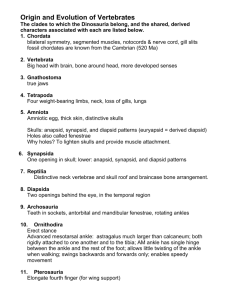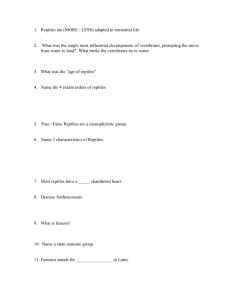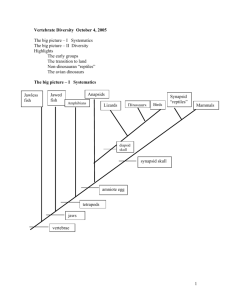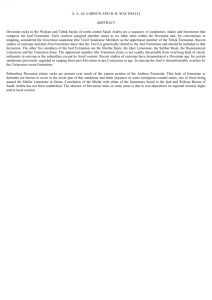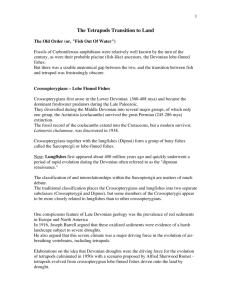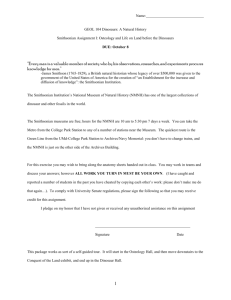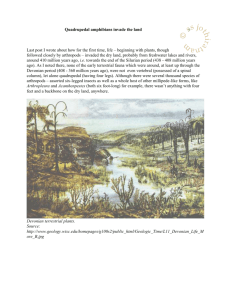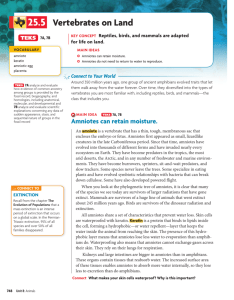Part 3 - Dinosaurs - How diversity is studied
advertisement
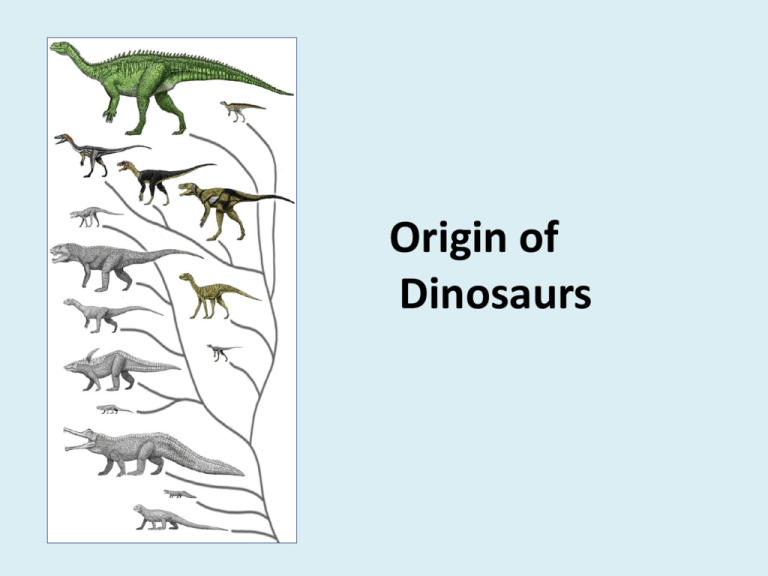
Origin of Dinosaurs How Diversity is studied Phylogenetics Hypthesizing Relationships A (vague) evolutionary tree Something more precise Cladogram A cladogram for dinosaurs and relatives A cladogram for advanced theropod dinosaurs Cladogram for group of North American stream fishes SMN’s ground-breaking work on African anabantid fishes Supraorbital pores of the cephalic lateralis Deep time – dinosaur ancestors Tetrapods are terrestrial adapted vertebrates – they have legs with feet First dinosaurs First tetrapods Tetrapods come out of the fish world † Eusthenopteron Tetrapoda Neotetrapoda Temnospondyli “Fishes” Actinistia (coelacanth) Lissamphibia Dipneusti (lungfish) *Diverse Devonian groups† Diverse tetrapod groups† Amniota (see Fig. 26.2) Anura Gymnophiona Urodela Ichthyostegans† Diverse temnospondyl groups† Characteristics of jaw, skull Modifications of skull bones (tentative) Three-lobed tail; ossified swim bladder; double jaw articulation Tetrapods † Panderichthys Tetrapod Origins Ray Troll Towards terrestrial tetrapods aquatic Semi-terrestrial Early tetrapod (fish-like) Later tetrapod (more terrestrial) † Acanthostega Early tetrapod trackway Eusthenopteron aquatic Semi-terrestrial aquatic Semi-terrestrial Panderichthys aquatic Semi-terrestrial Tiktaalik Acanthostega aquatic Semi-terrestrial Ichthyostega aquatic Semi-terrestrial Pederpes Not a fish Ichthyostega Acanthostega “Fishes” (more or less) Tiktaalik Panderichthys Eusthenopteron Nelson (2006): Tetrapods are a “divergent sideline within the fishes that ascends onto land and into the air and secondarily returns to water.” Early terrestrial tetrapods Very rich Paleozoic diversity of these creatures Carboniferous Era Great time to be an early terrestrial tetrapod Carboniferous 360-300 mya Very rich Paleozoic diversity of these creatures Amniotes Frogs and toads Anthracosauria Amniota Lepospondyli Salamanders Ichthyostega Lissamphibians Caecilians Dipneusti Diverse Devonian groups Sarcopterygian ancestor Diverse temnospondyl groups (includes Eusthenopteron, Tiktaalik, and Acanthostega) Coelacanth Devonian Carboniferous Permian PALEOZOIC 395 Geologic time (MY ago) MESOZOIC 252 CENOZOIC 66 Most gone – Two groups survived Reptiles / Mammals Amniotes Frogs and toads Anthracosauria Amniota Lepospondyli Amphibians Salamanders Ichthyostega Lissamphibians Caecilians Dipneusti Diverse Devonian groups Sarcopterygian ancestor Diverse temnospondyl groups (includes Eusthenopteron, Tiktaalik, and Acanthostega) Coelacanth Devonian Carboniferous Permian PALEOZOIC 395 Geologic time (MY ago) MESOZOIC 252 CENOZOIC 66 Very rich Paleozoic diversity of these creatures Amniotes Frogs and toads Anthracosauria Amniota Lepospondyli Salamanders Ichthyostega Lissamphibians Caecilians Dipneusti Diverse Devonian groups Sarcopterygian ancestor Diverse temnospondyl groups (includes Eusthenopteron, Tiktaalik, and Acanthostega) Coelacanth Devonian Carboniferous Permian PALEOZOIC 395 Geologic time (MY ago) MESOZOIC 252 CENOZOIC 66 on our way to amphibians Class Amphibia Very rich Paleozoic diversity of these creatures Amniotes Frogs and toads Anthracosauria Amniota Lepospondyli Salamanders Ichthyostega Lissamphibians Caecilians Dipneusti Diverse Devonian groups Sarcopterygian ancestor Diverse temnospondyl groups (includes Eusthenopteron, Tiktaalik, and Acanthostega) Coelacanth Devonian Carboniferous Permian PALEOZOIC 395 Geologic time (MY ago) MESOZOIC 252 CENOZOIC 66 On our way to mammals / reptiles Amniotes Reptiles Mammals Other Most gone – Two groups survived Reptiles / Mammals Amniotes Frogs and toads Anthracosauria Amniota Lepospondyli Amphibians Salamanders Ichthyostega Lissamphibians Caecilians Dipneusti Diverse Devonian groups Sarcopterygian ancestor Diverse temnospondyl groups (includes Eusthenopteron, Tiktaalik, and Acanthostega) Coelacanth Devonian Carboniferous Permian PALEOZOIC 395 Geologic time (MY ago) MESOZOIC 252 CENOZOIC 66 Carboniferous 360-300 mya Before we get to the Mesozoic, we have to survive the Permian Permian Carboniferous Permian – it all almost ends Permian – cooler and drier A new, drier, world favors a new type of tetrapod Amniotes Amniotes Amniotes Frogs and toads Anthracosauria Amniota Lepospondyli Salamanders Ichthyostega Lissamphibians Caecilians Dipneusti Diverse Devonian groups Sarcopterygian ancestor Diverse temnospondyl groups (includes Eusthenopteron, Tiktaalik, and Acanthostega) Coelacanth Devonian Carboniferous Permian PALEOZOIC 395 Geologic time (MY ago) MESOZOIC 252 CENOZOIC 66 Amniota Amnoita (living) Deriving Amniotes Carboniferous terrestrial habitats Permian – cooler and drier Post-Paleozoic is the age of amniotes The Mesozoic was really cool AGE OF AMNIOTES Adapting to the new conditions Moving away from water Amniotes Amnoites Frogs and toads Anthracosauria Amniota Lepospondyli Salamanders Ichthyostega Lissamphibians Caecilians Dipneusti Diverse Devonian groups Sarcopterygian ancestor Diverse temnospondyl groups (includes Eusthenopteron, Tiktaalik, and Acanthostega) Coelacanth Devonian Carboniferous Permian PALEOZOIC 395 Geologic time (MY ago) MESOZOIC 252 CENOZOIC 66 Amniota What’s going on at the beginning? Amniotic Egg Amniotic Egg Fish Amphibian Amniote Internal Fertilization No more gill breathing – even in larvae amphibian larvae Body covering Dry and dead Respiration Anamniotes – Positive Pressure Breathing Amniotes – negative pressure breathing Patterns in Skull Evolution Pre-Amniote Diadectes Pre-Amniote Skulls Anapsid Pre-Amniote Synapsid Diapsid anapsid skull and jaw muscles pre-amniote anapsid skull and jaw muscles pre-amniote foramen pre-amniote amniote Skulls Anapsid Synapsid Diapsid No foramen foramen present Anapsid Synapsid Diapsid Amniote ancestor Anapsid Diapsid Synapsid Mammals and ancestors Reptiles, birds, dinosaurs, etc. Anapsid anamniotes, stem amniotes Synapsid Synapsid Dimetrodon Synapsid Modern mammal Synapsid fenestra joined with orbit Modern mammal orbit Diapsid Diapsid orbit orbit Diapsid tuatara orbit Diapsid Modern Lizard Diapsid Modern snake Diapsid Modern bird orbit Diapsid orbit Mesozoic reptiles orbit Turtles Turtles are diapsids with a (secondarily acquired) anapsid skull Fenestration Clear proof of diapsids on Mars NASA Photos (Science Education is important) Jaw rearrangements The big split anapsid anamniote diapsid synapsid The big split The big split Synapsid lineage Diapsid radiation The big split Synapsids – only mammals remain All this is extinct Diapsids – many fossil groups, but many groups remain Some interesting parallels in evolution Endothermy warm-bloodedness Living Amniotes Synapsid Diapsid Endothermy warm-bloodedness Diapsids Synapsids Both groups Greater Mobility Greater Mobility Higher metabolism More heat generation better respiration better circulation waste heat elimination diet / digestion heat conservation / utilization What do we do with the heat? Diet Respiration ancestor towards mammals towards birds Circulation Some interesting parallels in evolution Reptiles and Diapsids
